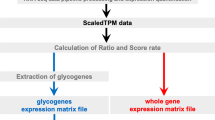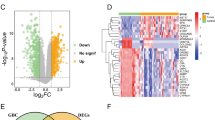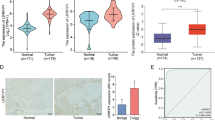Abstract
The classical cadherin gene has been linked to a variety of human malignancies, including gastric cancer. However, the link between cadherin genes and gastric cancer outcome is still unclear. This study used multi-omics data to examine the cadherin genes that were differentially regulated in gastric cancer. Differential expression of genes, epigenetic, molecular alterations, and protein expression analyses was conducted. Male SD rats were given N-methyl-N-nitrosourea (MNU) to induce stomach carcinoma in order to verify the activation of cadherin genes. CDH5, CDH6, CDH11, and CDH24 levels were found to be considerably higher in gastric cancer and may serve as useful indicators of stomach adenocarcinoma (STAD). Cadherin genes with variable expression had considerably more promoter methylation in cancers than in normal tissues. In individuals with gastric cancer, high expression of these cadherin genes was related to lower total mortality and disease-free survival rates. Furthermore, compared to normal rats, gastric cancer-induced rats had significantly higher expression and distribution of CDH5, CDH6, CDH11, and CDH24. This study sheds new light on the diagnosis and prognosis of gastric cancer by identifying potential prognostic markers such as CDH5, CDH6, CDH11, and CDH24. The multi-omics approach provided a potential tool for target-based therapy by accurately predicting the outcome of stomach cancer. Researchers may gain more knowledge about the role of cadherin genes in the development and dissemination of tumors to the activated rat model of gastric cancer.









Similar content being viewed by others
Data Availability
The following information was supplied regarding data availability: The raw measurements are available in the Supplemental File.
Abbreviations
- BP:
-
Biological processes
- CC:
-
Cell components
- CDH:
-
Cadherin
- CDH11:
-
Cadherin 11
- CDH24:
-
Cadherin 24
- CDH5:
-
Cadherin 5
- CDH6:
-
Cadherin 6
- CNV:
-
Copy number variation
- CO:
-
Control group
- CSCs:
-
Cancer stem cells
- DAVID:
-
Database for Annotation, Visualization, and Integrated Discovery
- DE:
-
Differentially expressed
- DFS:
-
Disease-free survival
- DNA:
-
Deoxyribonucleic acid
- EMT:
-
Epithelial-mesenchymal transition
- GBM:
-
Glioblastoma
- GC:
-
Gastric cancer
- GEPIA2:
-
Gene Expression Profiling Interactive Analysis version 2
- GO:
-
Gene ontology
- KEGG:
-
Kyoto Encyclopedia of Genes and Genomes
- KIRC:
-
Kidney renal clear cell carcinoma
- KM:
-
Kaplan-Meier
- MF:
-
Molecular function
- MNU:
-
N-Methyl-N-nitrosourea
- mRNA:
-
Messenger RNA
- OS:
-
Overall survival
- PBS:
-
Phosphate-buffered saline
- PPI:
-
Protein-protein interaction
- RNA:
-
Ribonucleic acid
- ROC:
-
Receiver operating characteristic
- SD:
-
Sprague Dawley
- STAD:
-
Stomach adenocarcinoma
- TCGA :
-
The Cancer Genome Atlas
- TPM:
-
Transcripts per million
References
Sung, H., Ferlay, J., Siegel, R. L., Laversanne, M., Soerjomataram, I., Jemal, A., & Bray, F. (2021). Global cancer statistics 2020: GLOBOCAN estimates of incidence and mortality worldwide for 36 cancers in 185 countries. CA: A Cancer Journal for Clinicians, 71, 209–249.
Karimi, P., Islami, F., Anandasabapathy, S., Freedman, N. D., & Kamangar, F. (2014). Gastric cancer: Descriptive epidemiology, risk factors, screening, and prevention gastric cancer. Cancer epidemiology, biomarkers & prevention, 23, 700–713.
Jamil, D., Palaniappan, S., Lokman, A., Naseem, M., & Zia, S. S. (2022). Diagnosis of gastric cancer using machine learning techniques in healthcare sector: A survey. Informatica, 45(7), 1.
Chivu-Economescu, M., Matei, L., Necula, L. G., Dragu, D. L., Bleotu, C., & Diaconu, C. C. (2018). New therapeutic options opened by the molecular classification of gastric cancer. World journal of gastroenterology, 24, 1942.
Lazăr, D. C., Tăban, S., Cornianu, M., Faur, A., & Goldiş, A. (2016). New advances in targeted gastric cancer treatment. World journal of gastroenterology, 22, 6776.
Moreira, A. M., Pereira, J., Melo, S., Fernandes, M. S., Carneiro, P., Seruca, R., & Figueiredo, J. (2020). The extracellular matrix: An accomplice in gastric cancer development and progression. Cells, 9, 394. https://doi.org/10.3390/cells9020394
Ucaryilmaz Metin, C., & Ozcan, G. (2022). Comprehensive bioinformatic analysis reveals a cancer-associated fibroblast gene signature as a poor prognostic factor and potential therapeutic target in gastric cancer. BMC Cancer, 22, 692–692. https://doi.org/10.1186/s12885-022-09736-5
Luo, S., Lin, R., Liao, X., Li, D., & Qin, Y. (2021). Identification and verification of the molecular mechanisms and prognostic values of the cadherin gene family in gastric cancer. Scientific reports, 11, 23674–23674. https://doi.org/10.1038/s41598-021-03086-1
Wendeler, M. W., Drenckhahn, D., Geßner, R., & Baumgartner, W. (2007). Intestinal LI-cadherin acts as a Ca2+-dependent adhesion switch. Journal of molecular biology, 370, 220–230.
Zhao, Z., Li, S., Li, S., Wang, J., Lin, H., & Fu, W. (2021). High expression of oncogene cadherin-6 correlates with tumor progression and a poor prognosis in gastric cancer. Cancer Cell International, 21, 493. https://doi.org/10.1186/s12935-021-02071-y
Yang, Z., Yan, C., Yu, Z., He, C., Li, J., Li, C., Yan, M., Liu, B., Wu, Y., & Zhu, Z. (2021). Downregulation of CDH11 promotes metastasis and resistance to paclitaxel in gastric cancer cells. Journal of Cancer, 12, 65–75. https://doi.org/10.7150/jca.48193
An, C. H., Je, E. M., Yoo, N. J., & Lee, S. H. (2015). Frameshift mutations of cadherin genes DCHS2, CDH10 and CDH24 genes in gastric and colorectal cancers with high microsatellite instability. Pathology Oncology Research, 21, 181–185. https://doi.org/10.1007/s12253-014-9804-8
Knipper, K., Fuchs, H. F., Alakus, H., Bruns, C. J., & Schmidt, T. (2023). Hereditary diffuse gastric cancer. Chirurgie (Heidelb). https://doi.org/10.1007/s00104-023-01806-z
Shenoy, S. (2019). CDH1 (E-cadherin) mutation and gastric cancer: Genetics, molecular mechanisms and guidelines for management. Cancer management and research, 11, 10477–10486. https://doi.org/10.2147/cmar.S208818
Chen, Y., Yuan, H., Yu, Q., Pang, J., Sheng, M., & Tang, W. (2022). Bioinformatics analysis and structure of gastric cancer prognosis model based on lipid metabolism and immune microenvironment. Genes (Basel), 13, 1581. https://doi.org/10.3390/genes13091581
Gao, J., Aksoy, B. A., Dogrusoz, U., Dresdner, G., Gross, B., Sumer, S. O., Sun, Y., Jacobsen, A., Sinha, R., Larsson, E., Cerami, E., Sander, C., & Schultz, N. (2013). Integrative analysis of complex cancer genomics and clinical profiles using the cBioPortal. Sci Signal, 6, l1. https://doi.org/10.1126/scisignal.2004088
Chandrashekar, D. S., Karthikeyan, S. K., Korla, P. K., Patel, H., Shovon, A. R., Athar, M., Netto, G. J., Qin, Z. S., Kumar, S., Manne, U., Creighton, C. J., & Varambally, S. (2022). UALCAN: An update to the integrated cancer data analysis platform. Neoplasia, 25, 18–27. https://doi.org/10.1016/j.neo.2022.01.001
Rich, J. T., Neely, J. G., Paniello, R. C., Voelker, C. C., Nussenbaum, B., & Wang, E. W. (2010). A practical guide to understanding Kaplan-Meier curves. Otolaryngology Head and Neck Surgery, 143, 331–336. https://doi.org/10.1016/j.otohns.2010.05.007
Tang, Z., Li, C., Kang, B., Gao, G., Li, C., & Zhang, Z. (2017). GEPIA: A web server for cancer and normal gene expression profiling and interactive analyses. Nucleic Acids Research, 45, W98-w102. https://doi.org/10.1093/nar/gkx247
Li, T., Fu, J., Zeng, Z., Cohen, D., Li, J., Chen, Q., Li, B., & Liu, X. S. (2020). TIMER2.0 for analysis of tumor-infiltrating immune cells. Nucleic Acids Research, 48, W509-w514. https://doi.org/10.1093/nar/gkaa407
Vasaikar, S. V., Straub, P., Wang, J., & Zhang, B. (2018). LinkedOmics: Analyzing multi-omics data within and across 32 cancer types. Nucleic Acids Research, 46, D956-d963. https://doi.org/10.1093/nar/gkx1090
Szklarczyk, D., Gable, A. L., Nastou, K. C., Lyon, D., Kirsch, R., Pyysalo, S., Doncheva, N. T., Legeay, M., Fang, T., Bork, P., Jensen, L. J., & von Mering, C. (2020). The STRING database in 2021: Customizable protein–protein networks, and functional characterization of user-uploaded gene/measurement sets. Nucleic Acids Research, 49, D605–D612. https://doi.org/10.1093/nar/gkaa1074
Dennis, G., Sherman, B. T., Hosack, D. A., Yang, J., Gao, W., Lane, H. C., & Lempicki, R. A. (2003). DAVID: Database for annotation, visualization, and integrated discovery. Genome biology, 4, 1–11.
Wu G, and Haw R. 2017. Functional interaction network construction and analysis for disease discovery. Protein Bioinformatics: From Protein Modifications and Networks to Proteomics 235–253
Almora-Pinedo, Y., Arroyo-Acevedo, J., Herrera-Calderon, O., Chumpitaz-Cerrate, V., Hañari-Quispe, R., Tinco-Jayo, A., Franco-Quino, C., & Figueroa-Salvador, L. (2017). Preventive effect of Oenothera rosea on N-methyl-N-nitrosourea-(NMU) induced gastric cancer in rats. Clinical and Experimental Gastroenterology, 10, 327–332. https://doi.org/10.2147/ceg.S142515
Yoon, S.-J., Park, J., Shin, Y., Choi, Y., Park, S. W., Kang, S.-G., Son, H. Y., & Huh, Y.-M. (2020). Deconvolution of diffuse gastric cancer and the suppression of CD34 on the BALB/c nude mice model. BMC Cancer, 20, 314.
Machlowska, J., Baj, J., Sitarz, M., Maciejewski, R., & Sitarz, R. (2020). Gastric cancer: Epidemiology, risk factors, classification, genomic characteristics and treatment strategies. International Journal of Molecular Sciences, 21, 4012. https://doi.org/10.3390/ijms21114012
Bos, J. L., & Burgering, B. M. (2004). Molecular mechanisms in signal transduction and cancer. EMBO Reports, 5, 855–859. https://doi.org/10.1038/sj.embor.7400220
Menyhárt, O., & Győrffy, B. (2021). Multi-omics approaches in cancer research with applications in tumor subtyping, prognosis, and diagnosis. Computational and Structural Biotechnology Journal, 19, 949–960. https://doi.org/10.1016/j.csbj.2021.01.009
Matsumura, T., Makino, R., & Mitamura, K. (2001). Frequent down-regulation of E-cadherin by genetic and epigenetic changes in the malignant progression of hepatocellular carcinomas. Clinical Cancer Research, 7, 594–599.
Basu, A., & Tiwari, V. K. (2021). Epigenetic reprogramming of cell identity: Lessons from development for regenerative medicine. Clinical Epigenetics, 13, 144. https://doi.org/10.1186/s13148-021-01131-4
Bougen-Zhukov, N., Nouri, Y., Godwin, T., Taylor, M., Hakkaart, C., Single, A., Brew, T., Permina, E., Chen, A., Black, M. A., & Guilford, P. (2019). Allosteric AKT inhibitors target synthetic lethal vulnerabilities in E-cadherin-deficient cells. Cancers (Basel), 11, 1359. https://doi.org/10.3390/cancers11091359
Luo, S., Lin, R., Liao, X., Li, D., & Qin, Y. (2021). Identification and verification of the molecular mechanisms and prognostic values of the cadherin gene family in gastric cancer. Science and Reports, 11, 23674. https://doi.org/10.1038/s41598-021-03086-1
Mita, H., Katoh, H., Komura, D., Kakiuchi, M., Abe, H., Rokutan, H., Yagi, K., Nomura, S., Ushiku, T., Seto, Y., & Ishikawa, S. (2023). Aberrant cadherin11 expression predicts distant metastasis of gastric cancer. Pathology - Research and Practice, 242, 154294. https://doi.org/10.1016/j.prp.2022.154294
Massari, G., Magnoni, F., Favia, G., Peradze, N., Veronesi, P., La Vecchia, C., & Corso, G. (2021). Frequency of CDH1 germline mutations in non-gastric cancers. Cancers, 13, 2321.
Corso, G., Corso, F., Bellerba, F., Carneiro, P., Seixas, S., Cioffi, A., La Vecchia, C., Magnoni, F., Bonanni, B., & Veronesi, P. (2021). Geographical distribution of E-cadherin germline mutations in the context of diffuse gastric cancer: A systematic review. Cancers, 13, 1269.
Higuchi, K., Inokuchi, M., Takagi, Y., Ishikawa, T., Otsuki, S., Uetake, H., Kojima, K., & Kawano, T. (2017). Cadherin 5 expression correlates with poor survival in human gastric cancer. Journal of clinical pathology, 70, 217–221.
Inokuchi, M., Higuchi, K., Takagi, Y., Tanioka, T., Nakagawa, M., Gokita, K., Okuno, K., & Kojima, K. (2017). Cadherin 5 is a significant risk factor for hematogenous recurrence and a prognostic factor in locally advanced gastric cancer. Anticancer research, 37, 6807–6813.
An, C. H., Je, E. M., Yoo, N. J., & Lee, S. H. (2015). Frameshift mutations of cadherin genes DCHS2, CDH10 and CDH24 genes in gastric and colorectal cancers with high microsatellite instability. Pathology & Oncology Research, 21, 181–185. https://doi.org/10.1007/s12253-014-9804-8
Author information
Authors and Affiliations
Contributions
Huan Wang was responsible for performing computational work, preparing figures and/or tables, and either authoring or reviewing article drafts, in addition to approving the final version. Baomin Zhang, on the other hand, was involved in conceiving and designing the experiments, conducting them, analyzing the data, performing computational work, preparing figures and/or tables, and either authoring or reviewing article drafts, as well as approving the final version.
Corresponding author
Ethics declarations
Ethical Approval
All animal-related experiments were authorized by the Qilu Hospital (Qingdao), Cheeloo College of Medicine, Shandong University Ethics Committee of China’s Faculty of Medicine with animal ethics number: KYDWLL-202327.
Consent to Participate
Not applicable.
Consent for Publication
Not applicable.
Competing Interests
The authors declare no competing interests.
Additional information
Publisher's Note
Springer Nature remains neutral with regard to jurisdictional claims in published maps and institutional affiliations.
Supplementary Information
Below is the link to the electronic supplementary material.
Rights and permissions
Springer Nature or its licensor (e.g. a society or other partner) holds exclusive rights to this article under a publishing agreement with the author(s) or other rightsholder(s); author self-archiving of the accepted manuscript version of this article is solely governed by the terms of such publishing agreement and applicable law.
About this article
Cite this article
Wang, H., Zhang, B. The Impact of Transcriptional Profiling Cadherin Family and Therapeutic Approaches of Gastric Cancer: A Translational Outlook on Multi-omics Data Analysis. Appl Biochem Biotechnol (2024). https://doi.org/10.1007/s12010-024-04926-2
Accepted:
Published:
DOI: https://doi.org/10.1007/s12010-024-04926-2




